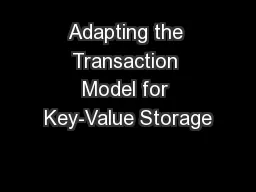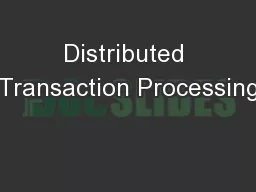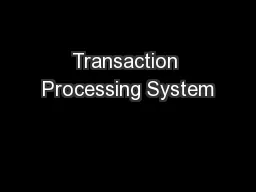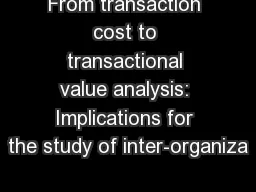PPT-Adapting the Transaction Model for Key-Value Storage
Author : luanne-stotts | Published Date : 2018-11-07
Ken Birman Spring 2018 httpwwwcscornelleducoursescs54122018sp 1 A 5lecture Roadmap httpwwwcscornelleducoursescs54122018sp 2 Lecture 1 Transactions Lecture 2 DHTs
Presentation Embed Code
Download Presentation
Download Presentation The PPT/PDF document "Adapting the Transaction Model for Key-V..." is the property of its rightful owner. Permission is granted to download and print the materials on this website for personal, non-commercial use only, and to display it on your personal computer provided you do not modify the materials and that you retain all copyright notices contained in the materials. By downloading content from our website, you accept the terms of this agreement.
Adapting the Transaction Model for Key-Value Storage: Transcript
Ken Birman Spring 2018 httpwwwcscornelleducoursescs54122018sp 1 A 5lecture Roadmap httpwwwcscornelleducoursescs54122018sp 2 Lecture 1 Transactions Lecture 2 DHTs Lecture 3. he year Design Value s based on the average of a 3 year period which includes the selected year plus the two prior years Also displayed is the following informat on for each year the umber of Complete Quarters for that year the 99 th Percentil samp value value value value value value Year Year Year Year Year Year Deflated final value 100 100 100 value Year 3 Year Year Year value STD Annual real growth rate 100 100 value value Year Year Year Average annual percentage growth rate 100 value 1. David . Lomet. Microsoft Research. Mohamed . Mokbel. University of Minnesota. Talk Outline. Unbundled. Transaction Services. Challenge: Key Range Locking. Using. Conventional . L. ocking. . M. anagers. Some of the slides have been borrowed from courses taught at Stanford, Berkeley, Washington, and earlier version of CS 223 at UCI . ICS214B. Notes 11. 2. .. Distributed . Transaction. Action:. a. Liew. . Woei. Song. Muhammad Hofiz Achoson. Introduction. Transaction Processing System. What is a TPS?. an information system designed to process routine business transactions . seeks time- and cost-efficiency by automating repetitive operations in large volumes. concurrency. . controll. Chapter. 13. “Distributed Systems: . Concepts and Design”. Coulouris. , . Dollimore. , Kindberg. Hanna. Björling, . Stina Fröjd & Liv Sundman. Transaction. A transaction is a point where there is interaction with the database. WHAT IS IT?. Preparing and modifying primary source documents so that all students can read and analyze them in their history classrooms.. Adapting Documents. RATIONALE. Often primary sources use complex or antiquated language. Hadoop. Spring 2012. Aviram. . Rehana. Lior. Zeno. Supervisor : Edward . Bortnikov. Agenda. The problem and . motivation. Background on databases’ access. What is done so far. Project goals. Effort assessment and roadmap . ISIS | 5500 Shared storage value Avid Stephen Gasteyer, Department of Sociology . Michigan State University. (. acknowledgement to Nicole Wall, Cody Knutson. , others) . . Goals of this Talk. Goal of this talk. Use CCF as a framework for analyzing the nexus between: . Adapting Curriculum Maps & Intro to Module . 3 . Grade 5. 1. ADAPTING CURRICULUM MAPS (GRADE 5). Welcome Back!. 2. Name 1. . . . . Name 2. . . . . . ADAPTING CURRICULUM MAPS (GRADE 5). Introduction: Who I Am. Zajac. , Edward J. & Olsen, Cyrus P.. Journal of Management Studies. , 30 (1): 131-145. Presented by Nan Zhang. Overview. Motivation. Two limiting emphases of transaction cost analysis. A transactional value framework. Global . Industry Standards. Presented by: . Nadeem Ajaib of . Icona. Global, . Colin Devine of Devine's Worldwide, . Aditya Loomba of ECO Limos, and . Ilpo. . Mäkinen. of Limousine Service Ltd.. . MASCIP Annual Conference. Loughborough University. 16. th. November 2023 . MEHDI BELBAHI. OCCUPATIONAL THERAPIST.
Download Document
Here is the link to download the presentation.
"Adapting the Transaction Model for Key-Value Storage"The content belongs to its owner. You may download and print it for personal use, without modification, and keep all copyright notices. By downloading, you agree to these terms.
Related Documents














